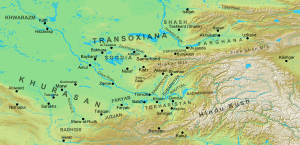Asad ibn Abdallah al-Qasri
Asad ibn Abdallah al-Qasri | |
|---|---|
| Died | February 738 Balkh |
| Years active | 724–738 |
| Known for | Twice Khurasan, defeated the Türgesh |
| Opponents | |
| Parent |
|
Asad ibn Abdallah al-Qasri (
After his dismissal, his successors reversed his policy of reconciliation, resulting in a large-scale anti-Arab rebellion among the Soghdians. Another major defeat against the Türgesh in the
Origin
Asad was a member of the Qasr clan, a subtribe of the
First governorship of Khurasan

In 724, immediately after
According to the historian
At the same time, Asad tried to conciliate the local population, hoping to prevent them from supporting the Türgesh. He continued his predecessor's policy of appointing men known for their honesty as his fiscal agents. His reforms aimed to stop discrimination against the
In 726 Asad rebuilt the city of
Asad was dismissed from his office in Ramadan 109 AH (December 727 or January 728 AD), when in an outburst of anger he had the chief representatives of the four greatest Arab tribes in Khurasan, the Ahl al-Aliyah, Azd, Tamim, and Bakr, publicly flogged. Caliph Hisham demanded his dismissal, and after naming al-Hakam ibn Awana al-Kalbi as his deputy, Asad returned to his brother in Iraq.[19]
Second governorship of Khurasan
Asad was replaced by
In early 735 Asad arrived once more to take up the governorship of Khurasan, this time accompanied by 20,000 Syrian troops, according to the 11th-century historian
The next year, 736, Asad's forces cleared the mountains of Upper Tokharistan from the remnants of Harith's supporters. Many of the latter, including some of Harith's relatives, were blockaded in the fortress of Tabushkhan by Asad's commander
In 737, Asad again led his troops north of the Oxus in a retaliatory campaign against Khuttal, whose ruler had allied himself with both Harith and the Türgesh. While Asad captured a few fortresses and pillaged the land, the Khuttalan regent, Ibn al-Sa'iji, called for aid from the Türgesh qaghan,
After his victory over the Türgesh, Asad sent an expedition against Badr Tarkhan, possibly a prince of
Legacy
Asad's second governorship was of crucial importance to the future of
References
- ^ a b Crone 1980, p. 102.
- ^ Hawting 1971, pp. 925–926.
- ^ Gibb 1960, p. 684.
- ^ Blankinship 1994, pp. 125–127.
- ^ Gibb 1923, pp. 65–66.
- ^ Gibb 1923, p. 66.
- ^ Blankinship 1994, p. 123.
- ^ Blankinship 1989, pp. 25–26.
- ^ Blankinship 1989, pp. 30–32, 34.
- ^ a b Blankinship 1994, p. 127.
- ^ Gibb 1923, p. 68.
- ^ Gibb 1923, p. 67.
- ^ Gibb 1923, pp. 68–69.
- ^ a b Gibb 1960, p. 685.
- ^ Frye 1975, p. 136.
- ^ Gibb 1960, pp. 684–685.
- ^ Blankinship 1989, pp. 26–27.
- ^ Gibb 1923, pp. 66–68.
- ^ Blankinship 1989, pp. 35–38.
- ^ Blankinship 1994, pp. 127–128.
- ^ Gibb 1923, pp. 69–72.
- ^ Blankinship 1994, pp. 155–161.
- ^ Gibb 1923, pp. 72–76.
- ^ Shaban 1979, pp. 118–120.
- ^ Blankinship 1994, pp. 176–178.
- ^ Gibb 1923, pp. 76–77.
- ^ Blankinship 1989, pp. 111–112.
- ^ Shaban 1979, p. 120.
- ^ Shaban 1979, pp. 120–121.
- ^ Blankinship 1994, pp. 178–179.
- ^ Blankinship 1994, pp. 179–180.
- ^ Shaban 1979, p. 121.
- ^ Gibb 1923, pp. 77–78.
- ^ Shaban 1979, pp. 121–122.
- ^ Blankinship 1989, pp. 126–128.
- ^ Gibb 1923, pp. 80–81.
- ^ Shaban 1979, pp. 122–123.
- ^ Blankinship 1989, pp. 125–126.
- ^ Blankinship 1989, pp. 131–139.
- ^ Gibb 1923, pp. 81–83.
- ^ Shaban 1979, p. 124.
- ^ Blankinship 1989, pp. 139–147.
- ^ Gibb 1923, pp. 83–84.
- ^ Shaban 1979, pp. 125–126.
- ^ a b Blankinship 1989, pp. 162–164.
- ^ Shaban 1979, p. 126.
- ^ a b Blankinship 1994, p. 182.
- ^ Shaban 1979, p. 127.
- ^ Gibb 1923, pp. 84–85.
- ^ Gibb 1923, pp. 88–89.
- ^ Gibb 1923, pp. 89–98.
Sources
- ISBN 978-0-88706-569-9.
- ISBN 978-0-7914-1827-7.
- ISBN 0-521-52940-9.
- ISBN 0-521-20093-8.
- OCLC 499987512.
- OCLC 495469456.
- OCLC 495469525.
- Shaban, M. A. (1979). The ʿAbbāsid Revolution. Cambridge: Cambridge University Press. ISBN 0-521-29534-3.
